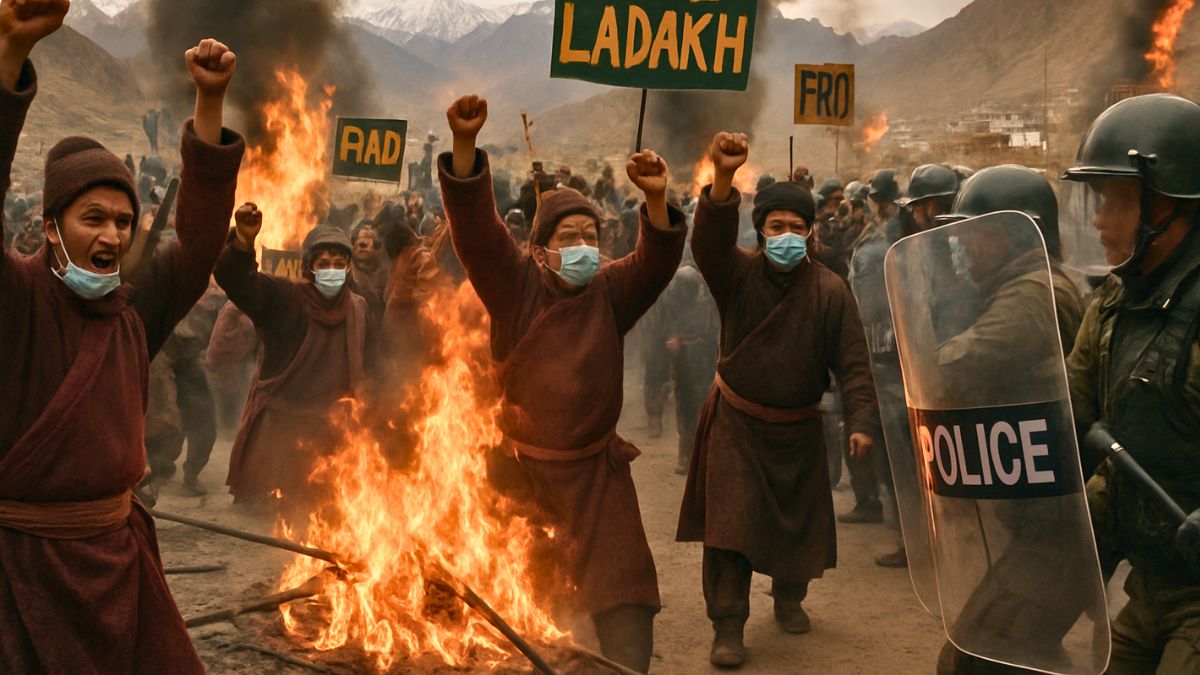Tensions remain high in Ladakh following violent clashes in Leh on September 24, 2025 that claimed four lives and several injured. The unrest, rooted in long-standing demands tied to political rights and land safeguards, has prompted tight restrictions, stalled talks, and raised concerns from local groups and authorities alike.
Two of the four killed were cremated on Sunday (September 28, 2025) and the ceremony was attended by a small group of relatives of 25-year-old Jigmat Dorjee and 24-year-old Stanzin Namgyal under heavy security. Even locals weren’t allowed to gather for the ceremony.
Dorjee and Namgyal lost their lives in the recent violent protests over the demand for statehood and Sixth Schedule status for Ladakh.
What triggered the violence?
A protest in Leh turned violent on September 24, 2025, when security personnel allegedly opened fire on demonstrators in the Phyang area. The demonstrators were reportedly agitating over demands that include statehood for Ladakh and constitutional safeguards under the Sixth Schedule.
The deaths further intensified anger among the local population and widened the standoff with authorities.
What restrictions have been imposed under Section 163 of BNSS?
Authorities in Leh continue to enforce prohibitory orders under Section 163 of the Bharatiya Nagarik Suraksha Sanhita (BNSS). The restrictions include ban on public gatherings and processions, suspension of mobile internet in several pockets, tight vigil at entry and exit points of the city, heavy deployment of security forces in sensitive zones.
Officials say the curbs are necessary to prevent flare-ups and restore peace. Markets and tourist movement have been partially impacted, with local administration asking residents to stay indoors unless necessary.
What is the stand of the Leh Apex Body on dialogue?
The Leh Apex Body (LAB), one of the leading groups spearheading the agitation, has said it will not resume talks with the government until “normalcy is fully restored.” LAB leaders have demanded that a judicial probe be initiate in the firing incident; compensation be given to families of the deceased; withdrawal of cases against protesters; and removal of restrictions on peaceful gatherings.
They declared that any engagement with the administration would be “meaningless” until trust is rebuilt on the ground. The Kargil Democratic Alliance (KDA), which has been working jointly with the LAB, has echoed this stance.
KDA member Sajjad Kargili has called for the unconditional release of climate activist and educator Sonam Wangchuk, who was taken in custody under the stringent National Security Act (NSA) and lodged in a Jodhpur jail, and other youth leaders detained in Leh.
How has the administration responded?
District authorities have appealed for calm and called the situation “sensitive but under control.” They have maintained that the restrictions are temporary and aimed at preventing further violence. The local government has not yet announced any inquiry into the firing. Senior officers have been holding internal reviews, but no formal meeting with protest leaders has taken place since the clashes.
For now, Ladakh remains under tight security, with its core political demands overshadowed by deaths, grief and distrust.
